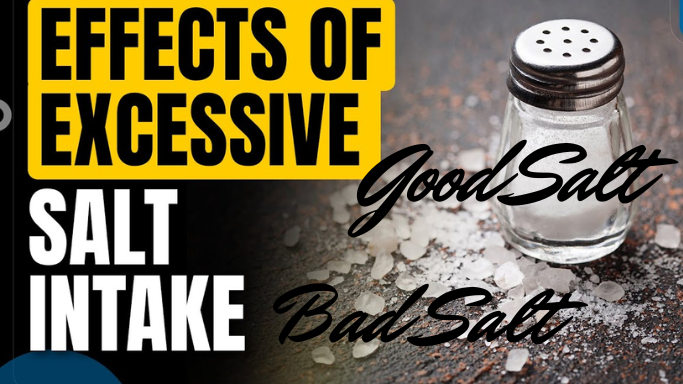Salt, or sodium chloride, is a mineral that has been an integral part of human diets for centuries. It has been used for seasoning, preservation, and even in medicinal contexts. But when it comes to health, the question remains: is salt good or bad for you? The answer isn’t entirely straightforward, and the debate continues in nutrition and health circles. Here’s a deeper look at the pros and cons of salt, and how to find a balance for optimal health.
The Case for Salt: Why It’s Good for You
Salt is vital for numerous biological functions in the body. Sodium, one of its components, helps regulate several important processes, including:
Fluid Balance: Sodium helps maintain the body’s fluid balance by regulating the amount of water inside and outside of cells. This is essential for maintaining proper hydration levels.
Nerve and Muscle Function: Sodium is involved in transmitting nerve signals and ensuring proper muscle contractions. It is essential for normal electrical activity in nerves and muscles, which is why an adequate sodium intake is necessary for muscle function and heart health.
Blood Pressure Regulation: Sodium helps regulate blood volume and blood pressure. It works in tandem with potassium to help control blood pressure, which is why balance is important. Too little sodium can result in low blood pressure, while too much can cause high blood pressure.
Electrolyte Balance: Along with other minerals like potassium and magnesium, sodium helps maintain the balance of electrolytes in the body, which is crucial for normal cell function.
The Case Against Salt: When Too Much Becomes Harmful
While salt is necessary for proper health, consuming too much can lead to serious health problems. This is why moderation is key, and overconsumption of salt has been linked to:
High Blood Pressure (Hypertension): One of the most well-documented risks of excessive salt intake is high blood pressure. When the body takes in too much sodium, it retains more water to balance the sodium levels, which increases blood volume and puts extra pressure on blood vessel walls. Over time, this leads to hypertension, which is a leading cause of heart disease, stroke, and kidney disease.
Heart Disease and Stroke: Excess sodium intake contributes to the development of cardiovascular problems. High blood pressure from excessive salt intake puts added strain on the heart and blood vessels, increasing the risk of heart disease, heart attacks, and strokes.
Kidney Damage: The kidneys are responsible for filtering out excess sodium from the bloodstream. When the kidneys are overburdened with too much sodium, they become less effective at filtering waste, leading to kidney damage and kidney disease over time.
Osteoporosis: A high-salt diet can cause calcium loss in urine, leading to lower bone mineral density. Over time, this can increase the risk of osteoporosis, especially in older adults.
Water Retention and Bloating: Excess sodium can cause the body to retain water, leading to bloating, puffiness, and discomfort. This is a temporary effect but can be problematic for people who are sensitive to salt.
How Much Salt Is Too Much?
The recommended daily sodium intake varies slightly depending on the health organization. According to the World Health Organization (WHO), adults should consume no more than 2,000 mg of sodium per day—roughly equivalent to 5 grams of salt. In the United States, the Dietary Guidelines for Americans (DGA) recommend a maximum of 2,300 mg of sodium per day, while the American Heart Association (AHA) suggests a more conservative target of 1,500 mg per day, especially for individuals with risk factors for heart disease.
Most people, however, consume much more salt than recommended, primarily from processed and restaurant foods. The average American consumes about 3,400 mg of sodium per day, far exceeding the safe limit.
Finding the Balance: How to Enjoy Salt Without Overdoing It
The key to using salt in a healthy diet is moderation and balance. Here are some tips for getting the right amount of salt:
Cook at Home: Cooking meals from scratch allows you to control the amount of salt you add. Instead of reaching for the salt shaker, try using herbs, spices, garlic, lemon, and other seasonings to add flavor.
Limit Processed Foods: Processed foods, like canned soups, frozen meals, packaged snacks, and fast food, are often high in hidden sodium. Read labels carefully to find lower-sodium options or choose fresh, whole foods when possible.
Read Nutrition Labels: Pay attention to sodium content in packaged foods. Look for products labeled "low sodium" or "no added salt," and avoid those with a high sodium per serving count.
Use a Salt Substitute: If you're looking to reduce your sodium intake but still want to add flavor to your food, try using potassium-based salt substitutes or seasoning with non-sodium alternatives, such as Mrs. Dash or other sodium-free blends.
Watch Out for Hidden Sodium: Sodium is often added to foods you might not expect, such as bread, breakfast cereals, and sauces. Check nutrition labels on all foods, even those that don’t seem particularly salty.
The Bottom Line: Is Salt Good or Bad for You?
Salt is not inherently "bad" for you—it's essential for several bodily functions, and a certain amount is necessary for health. However, too much salt can have serious consequences, particularly for blood pressure and heart health. The key is moderation: consume salt within the recommended guidelines, focus on whole, fresh foods, and be mindful of hidden sodium in processed and restaurant foods.
Finding a balance that works for your health needs will allow you to enjoy salt’s benefits while minimizing its risks. If you have specific health conditions like high blood pressure, it's always best to consult with a healthcare professional to tailor your sodium intake to your personal needs.




